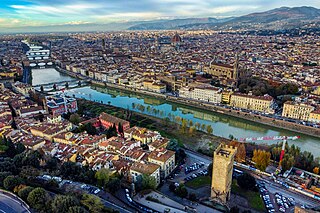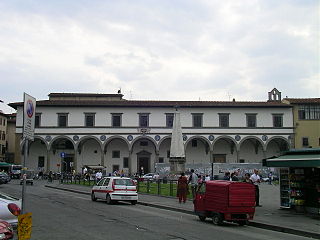
Florence is the capital city of the Italian region of Tuscany. It is also the most populated city in Tuscany, with 360,930 inhabitants in 2023, and 984,991 in its metropolitan area.

Via Monte Napoleone, also spelled Via Montenapoleone, is an upscale shopping street in Milan, Italy, Europe's most expensive street and the second most expensive street in the world after Fifth Avenue in New York City (2023). It is famous for its ready-to-wear fashion and jewelry shops, and for being the most important street of the Milan fashion district known as the Quadrilatero della moda, where many well-known fashion designers have high-end boutiques. The most exclusive Italian shoemakers maintain boutiques on this street.

Filippo di ser Brunellesco di Lippo Lapi, commonly known as Filippo Brunelleschi and also nicknamed Pippo by Leon Battista Alberti, was an Italian architect, designer, goldsmith and sculptor. He is considered to be a founding father of Renaissance architecture. He is recognized as the first modern engineer, planner, and sole construction supervisor. In 1421, Brunelleschi became the first person to receive a patent in the Western world. He is most famous for designing the dome of the Florence Cathedral, and for the mathematical technique of linear perspective in art which governed pictorial depictions of space until the late 19th century and influenced the rise of modern science. His accomplishments also include other architectural works, sculpture, mathematics, engineering, and ship design. Most surviving works can be found in Florence.

Santa Maria Novella is a church in Florence, Italy, situated opposite, and lending its name to, the city's main railway station. Chronologically, it is the first great basilica in Florence, and is the city's principal Dominican church.

Chartreuse is a French herbal liqueur available in green and yellow versions that differ in taste and alcohol content. The liqueur has been made by Carthusian monks since 1737 according to instructions set out in a manuscript given to them by François Annibal d'Estrées in 1605. It was named after the monks' Grande Chartreuse monastery, located in the Chartreuse Mountains north of Grenoble. Today the liqueur is produced in their distillery in nearby Aiguenoire. It is composed of distilled alcohol aged with 130 herbs, plants and flowers.

Lorenzo di Pietro, known as Vecchietta, was an Italian Sienese School painter, sculptor, goldsmith, and architect of the Renaissance. He is among the artists profiled in Vasari's Le Vite delle più eccellenti pittori, scultori, ed architettori.

San Miniato al Monte is a basilica in Florence, central Italy, standing atop one of the highest points in the city. It has been described as one of the finest Romanesque structures in Tuscany and one of the most scenic churches in Italy. There is an adjoining Olivetan monastery, seen to the right of the basilica when ascending the stairs.

The Pazzi Chapel is a chapel located in the "first cloister" on the southern flank of the Basilica di Santa Croce in Florence, Italy. Commonly credited to Filippo Brunelleschi, it is considered to be one of the masterpieces of Renaissance architecture.
Basilica of St. Mary may refer to:

Sant'Anna dei Lombardi,, and also known as Santa Maria di Monte Oliveto, is an ancient church and convent located in piazza Monteoliveto in central Naples, Italy. Across Monteoliveto street from the Fountain in the square is the Renaissance palace of Orsini di Gravina.

Santa Maria della Scala is a titular church in Rome, Italy, located in the Trastevere rione. Cardinal Ernest Simoni took possession of the titular church on 11 February 2017. Santa Maria della Scala is a titular church.

Andrea della Robbia was an Italian Renaissance sculptor, especially in ceramics.

Peretola is a suburb of Florence, Italy, located on the northern extremity of the Florentine commune. It belongs administratively to Quartiere 5 - Rifredi. It lend its name to the nearby international airport and is claimed as the birthplace of Amerigo Vespucci.

Acqua di Parma is an Italian lifestyle and fashion company that produces fragrances, candles, bathrobes, and leather accessories. All of its ranges are exclusively made in Italy, and distributed in 43 countries.

The historic centre of Florence is part of quartiere 1 of the Italian city of Florence. This quarter was named a World Heritage Site by UNESCO in 1982.

Armenian paper is a type of incense that has been produced for centuries. The paper is infused with essences, fragrances or essential oils in order to achieve a perfuming or cleansing effect. Examples of Armenian paper include Papier d'Arménie, which is produced in France, and Carta d'Armenia, which is produced in Italy. The scents from the French production is "Tradition", "Arménie" and "Rose".

The Museo Nazionale Alinari della Fotografia, formerly Museo della Storia della Fotografia Fratelli Alinari is a photography museum located in part of the premises of the former Ospedale di San Paolo in the Piazza Santa Maria Novella in Florence, region of Tuscany, Italy). It hosts special exhibitions on a regular basis and possesses 350.000 vintage prints from the 19th and 20th centuries. The museum closed in 2012.
The Hospital of San Paolo, later known as the Spedale of the Leopoldine, is a former hospital from the 13th century, now museum of modern works, located on Piazza Santa Maria Novella number 10, in Florence, region of Tuscany, Italy.

Carmelina Rotundo is an Italian journalist, blogger and teacher.




















